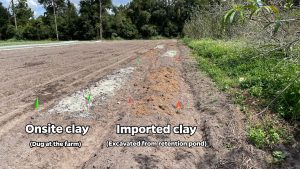GAINESVILLE, FL – Siembra Farm is a 15 acre diversified, sustainable vegetable farm which was the site of a Southern SARE research project primarily focused on nutrient and water management in organic vegetable systems in North Central Florida. UF/IFAS Soil, Water and Ecosystems Services researcher, Dr. Gabriel Maltais-Landry, says the main project at Siembra was comparing two different clays as soil amendments.
“So we added one clay that was coming from on site and then another one that was delivered from the company. We installed the moisture sensors below the plots that were amended with clay, installed drip irrigation, although we could have used sprinkler as well, but we focused on drip here, then planted cabbages for two years and looked at nutrient cycling, soil, health, weeds, nematodes and economics.”
Siembra owner Cody Galligan was interested in using clay amendments on the farm. “In Florida, we have very sandy soil. A couple of the big problems with sandy soil is nutrient retention and moisture retention. We hypothesized that clay would kind of help with both of those issues. It’s also super abundant and sustainably sourced here in Florida.”
For Galligan, it seemed like it would be a good fit for a sustainable farm. He says that even though clay is very abundant locally, the biggest challenge was finding someone who’s willing to load, haul and deliver it. “The way we sourced clay was just working with local construction companies that were excavating the clay either from retention ponds or construction sites. So they’re just generating this clay as a byproduct. It was challenging to know how good the clay was going to be before sourcing it, but it was basically free. We just paid for the truck to bring it here. So it didn’t feel like a big risk.”
Galligan adds, “Determining the quality of the clay basically kind of just involved. Like looking at the clay, feeling the clay, and kind of getting a sense of how slippery, soft and pure it was. We also did like a jar test where we’d check it in a jar and see what proportions of sand and clay were present in there. The outcomes we were expecting were increased moisture content in the soil. Hopefully that would translate into increased harvest size on the cabbages. And we did observe trends on both of those things. We observed a trend of increased moisture content in the soil and increased head size on the cabbages.”
One item that Galligan says worked out was the farm’s use of organic practices that utilizes a manure spreader, which became a pretty crucial implement for getting the clay out. “So I’m not sure how many conventional farms would have that technology on hand. And if you had to factor in the investment of getting a manure spreader, how much that equation would change. But because we had already had a loader and a manure spreader, there is really no investment beyond the small investment in the clay itself. So for spreading the clay, just the weight of the clay, I can get a little more clay into the spreader. I’m adding some compost or some mulch in there just to kind of help it flow out and not bog the spreader down.”
The top question that remains for Galligan, and that he would still like to investigate, is taking this project to a larger scale and in a in a more nutrient poor soil and maybe even non-irrigated soil.
What would be the effect of adding clay in an environment like a pasture or a corn field where it’s not being irrigated and the plants are undergoing more stress? How would having clay in the soil affect that? My main take home for using clay to improve nutrient and moisture management is that is worth further investigation. Like we saw enough of a trend in both crop size crop yield and moisture retention that it’s worth further investigation in different environments and on different scales.”
Dr. Eban Bean, with UF/IFAS Agricultural and Biological Engineering, also participated in the study and made the following observations. “We added clay to these sandy soils to shift the particle sizes. We wanted to have smaller particles like clays and silts into these soils so that we could reduce the pore sizes. By reducing the pore size, we actually improve the amount of water that the soil can hold and provide to plants. In sandy soils that water drains through really quickly. By reducing the pore size, we hold that water longer and it provides it to the plants more effectively. I think it’s important to mention here that this site, the soils, although they’re sandy, already had pretty high organic content. Five per cent, which is pretty high for Florida soils.”

Bean says that adding the clay didn’t have as much of an impact on the water retention as they probably would have seen with lower organic, more natural sandy soils that they would typically find. So they would be more likely to see significant differences between the treatments if they had started out with lower organic soils.
“Overall, though, I think we can see that even though we didn’t have significant differences, we saw trends by higher soil moisture from the treatments, greater yields with the size of the cabbage that was harvested from the project with the treatment of the clay, and overall, we think this is a very beneficial and productive result from the study.”
For a complete progress report on this project, visit: Optimizing Nutrient and Water Management for Organic Mixed Vegetable Production Systems
Tell us what you learned by taking this survey: Siembra Farms Research Survey
Video Producer: Luke Humplett
Production Liaison: Tatiana Sanchez-Jones, UF/IFAS Extension Alachua County
Principal Investigator: Gabriel Maltais-Landry, UF/IFAS Soil, Water and Ecosystem Services
Co-Principal Investigators: Kevin Athearn, Carlene Chase, Eban Bean and Tatiana Sanchez-Jones
 0
0
